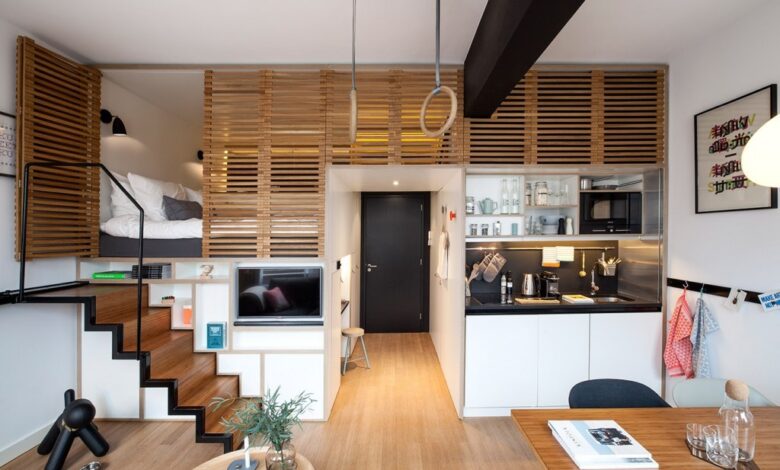Studio Apartment Essentials: Must-Have Furniture for Small Spaces

Studio apartments are becoming increasingly popular, especially in bustling cities where space is limited and the cost of living is high. These compact living spaces offer a unique set of challenges and opportunities when it comes to design, functionality, and decoration. Whether you’re moving into your first studio apartment or looking to maximize the potential of your current one, there are many ways to make the most out of every square inch. This guide will explore how to optimize space, design for functionality, and decorate your studio apartment with style.
1. Understanding Studio Apartments
What is a Studio Apartment?
A studio apartment, also known as an efficiency apartment, is a self-contained unit where the living, sleeping, and dining areas are all combined into one open space. Typically, there is no separate bedroom or walls dividing different areas of the home. Studio apartments are known for their compact size, with some being as small as 200 to 500 square feet, making them a great choice for those seeking affordable, minimalistic living options in urban environments.
The main difference between a studio apartment and a one-bedroom apartment is the lack of a dedicated, enclosed sleeping area. While some studios may feature small partitions or dividers to create distinct zones, the space is generally open and versatile. In larger cities, studio apartments are particularly popular due to their affordability and central locations, offering residents the opportunity to live near work, school, or entertainment without breaking the bank.
Who Typically Lives in a Studio Apartment?
Studio apartments are especially well-suited for singles, students, young professionals, or anyone who prefers a more minimalist lifestyle. The simplicity of a studio apartment means there is less upkeep, lower utility bills, and reduced overall expenses, making it a viable option for those on a budget. The convenience of a smaller space allows residents to focus on what truly matters while keeping living costs at a minimum.
In addition to affordability, studio apartments can be ideal for individuals who appreciate open, flexible spaces. Whether you’re an artist, a minimalist, or just someone who enjoys having everything within arm’s reach, the design of a studio apartment offers a level of versatility that larger apartments may lack. Though the space is smaller, the compact nature often fosters a sense of coziness and simplicity that many find appealing.
2. Designing Your Studio Apartment for Maximum Functionality
Smart Layouts: Making the Most of Limited Space
One of the first challenges in designing a studio apartment is the layout. With limited space, it’s essential to think strategically about how to arrange furniture and define areas within the apartment. An open floor plan is both a blessing and a curse — while it allows for flexibility, it can also make the apartment feel chaotic if not planned properly.
To make the most out of your studio apartment layout, it’s crucial to create a sense of order without compromising on style. Start by zoning the space into functional areas. You can use furniture to create natural divisions between the living, sleeping, and dining areas. For example, a sofa can act as a divider between the living and sleeping zones, while a rug can define the dining area. Be mindful of the flow of movement and avoid overcrowding the space with bulky furniture.
Additionally, opt for space-saving furniture. A Murphy bed or a fold-out couch can be perfect for small spaces, allowing you to transform the layout from day to night with ease. By thinking creatively about how to arrange your furniture, you can create a functional and efficient space that feels both open and cozy.
Furniture Essentials for Studio Apartments
When it comes to choosing furniture for a studio apartment, less is definitely more. Every piece of furniture should serve multiple purposes to maximize the available space. Invest in multifunctional items that can help you save room and stay organized. For instance, an ottoman with hidden storage can double as both seating and a place to store blankets or magazines.
Storage-savvy furniture is another essential for studio apartments. Consider wall-mounted shelves, foldable desks, and stackable chairs that can be tucked away when not in use. A coffee table with hidden compartments can store items you don’t need on a daily basis, like seasonal decorations or extra bedding. The key is to ensure that every piece of furniture is practical without sacrificing comfort.
Lastly, choosing lightweight and movable furniture allows you to change up the layout easily, especially if you’re someone who enjoys rearranging your space. Keep in mind that furniture in a studio apartment should help keep the space open and airy, so avoid heavy, dark pieces that can make the room feel smaller than it is.
3. Decorating Your Studio Apartment with Style
Color Schemes and Themes for Small Spaces
Color plays a crucial role in the overall feel of your studio apartment. Light colors like whites, creams, and pastels can create an illusion of a larger, more open space. These colors reflect light, making the room feel brighter and more expansive. If you prefer deeper tones, consider using them as accents rather than the primary color to avoid overwhelming the space.
Incorporating a color theme throughout your studio apartment can help tie the entire space together. You can introduce complementary colors through your choice of furniture, textiles, and decorative accents like curtains, cushions, and throws. Neutral tones such as grey, beige, and navy are versatile choices that work well in a variety of design schemes, but don’t shy away from adding pops of bold colors to bring personality to your space.
Accent walls are another great way to introduce depth and interest into a small studio. A single wall painted in a bold color or adorned with wallpaper can give the room character without making it feel too cramped. Consider using metallics, dark colors, or textured wallpaper for added visual impact, and complement these with lighter furniture and décor to keep the space balanced.
Flooring and Textiles: Adding Comfort and Character
The flooring in your studio apartment can set the tone for the entire space. Wood, bamboo, and laminate flooring are all great options for small apartments because they help create a warm, inviting atmosphere while still being easy to maintain. Rugs can further enhance the design of your apartment by providing comfort, adding color, and defining different areas of the space.
When selecting textiles for your studio, keep it simple yet cozy. Soft curtains can add privacy to your space while also serving as a way to control light and temperature. Layering pillows and throws on your bed or sofa can instantly make the space feel more comfortable and inviting. Look for textiles that complement your color scheme, and don’t be afraid to mix different textures like velvet, linen, and cotton for visual interest.
Personalizing your space with textiles and flooring is one of the easiest ways to bring life and style to your studio apartment. Whether you choose bold patterns or subtle designs, these elements can create a space that feels both cozy and uniquely yours.
4. Maximizing Storage in a Studio Apartment
Creative Storage Solutions
In a studio apartment, maximizing storage is essential to maintaining a tidy and functional space. The key is to use every available inch of your apartment. Vertical storage is a game-changer — tall shelves, cabinets, and hooks can help you store items up high, keeping the floor space clear. Wall-mounted racks or floating shelves are also excellent for organizing books, plants, or decor without taking up valuable space.
Look for furniture that doubles as storage. A storage bench at the foot of your bed can house extra linens, while a coffee table with drawers can keep small items out of sight. Under-bed storage is another great way to stow away seasonal clothing or extra shoes. You can even go a step further and use under-cabinet spaces in your kitchen or bathroom for organizing cleaning supplies and toiletries.
Organizing Small Items: Keeping Clutter at Bay
The key to keeping your studio apartment organized is to be intentional with your belongings. Keep only what you truly need or love, and regularly declutter to avoid accumulating unnecessary items. Consider investing in storage bins, baskets, and organizers that can fit neatly into closets, shelves, or even under your bed.
Smart organization doesn’t just apply to large items — small, everyday items like keys, mail, and electronics can quickly clutter up your studio. Use drawer organizers or small baskets to keep these items tidy and accessible. A little bit of organization can go a long way in maintaining a clean, uncluttered space.
Conclusion
Living in a studio apartment presents a unique set of challenges, but with the right approach, it can be a rewarding and enjoyable experience. By carefully planning the layout, choosing multi-functional furniture, and incorporating smart storage solutions, you can create a space that feels open, comfortable, and stylish. Remember that every inch counts in a small apartment, and with a little creativity and thoughtful design, your studio can be transformed into a functional and personalized living space.




